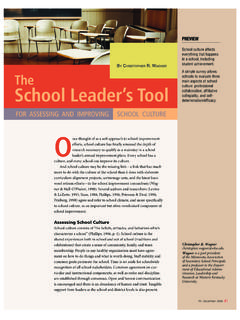Transcription of Building Strong Clubs - ClubExpress
1 < < strong >Strongstrong > >Buildingstrong >Strongstrong > > < strong >Strongstrong > < < strong >Strongstrong > >Clubsstrong >Strongstrong > > By Dan Ehrmann President, < < strong >Strongstrong > >ClubExpressstrong >Strongstrong > > Introduction At the typical < strong >clubstrong > or association: 5% of members run the < strong >clubstrong > and show up for almost every event; Another 15% of members regularly participate; Another 20% occasionally participate; The remaining 60% never show up for anything! Many < < strong >Strongstrong > >Clubsstrong >Strongstrong > > have a turnover rate of 15-20% per year. People leave because they lose interest, they have health or financial problems, they move away or pass away, or because they are no longer being served by the < strong >clubstrong > and the "product" it offers. Some < < strong >Strongstrong > >Clubsstrong >Strongstrong > > lose people because they cannot even get renewal notices sent out reliably, so members have no idea that it's time to renew.
2 Some < < strong >Strongstrong > >Clubsstrong >Strongstrong > > just don't market themselves very well, figuring that "passion" alone is enough to keep people interested and paying their dues. But most of the time it isn't! With these statistics in mind, how do you build < strong >Strongstrong > and vibrant < < strong >Strongstrong > >Clubsstrong >Strongstrong > > and associations that actually grow and survive more than a few years? People get disillusioned or tired out and others need to step in and take up the mantle of responsibility. Running a < strong >clubstrong > can be a huge amount of work, with the only compensation being the complaints of other members. And yet as we all know, being a member of < strong >clubstrong > and participating in its activities has enormous rewards. We get to share our passion with others who have the same passion.
3 We learn new things all the time and make new and lasting friendships. We get to do good deeds, strengthening our communities and the environment, and < < strong >Strongstrong > >Buildingstrong >Strongstrong > > bonds with other communities, sometimes across the country. So the question that all boards of directors ask is: how do we create a < strong >Strongstrong > < strong >clubstrong > or association, one that members want to join and renew, one with a < strong >Strongstrong > and growing core of active members, one with a "virtuous cycle" of people who get involved, which in turn generates more events and discussion and knowledge-exchange, which in turn gets more people to join and renew. Copyright, 2008 < < strong >Strongstrong > >ClubExpressstrong >Strongstrong > > All Rights Reserved Page 1 < < strong >Strongstrong > >Buildingstrong >Strongstrong > > a < strong >Strongstrong > < strong >clubstrong > or association is like < < strong >Strongstrong > >Buildingstrong >Strongstrong > > a < strong >Strongstrong > business.
4 You need to focus on the fundamentals: An attractive product at a good price that people want to buy! Marketing professionals talk about the " "s of < < strong >Strongstrong > >Buildingstrong >Strongstrong > > successful brands and growing businesses, and we can adapt those to this discussion. Each of these topics is discussed in more detail on the following pages: 1. Product & Positioning 2. Promotion 3. Price 4. People 5. Process 6. Passion 1. Product & Positioning How do you add value to people's lives? Some < < strong >Strongstrong > >Clubsstrong >Strongstrong > > and associations don't have a clear idea of who their market is and what their members are looking for. They may think they know, but it's easy for entrenched board members and activists to assume that everyone in the < strong >clubstrong > thinks the same way they do and is looking for the same things.
5 And it's easy for member needs to change without the Board quite realizing that this is happening. It's a good idea to survey your members on a periodic basis to < strong >findstrong > osatisfied they are with the < strong >clubstrong > and its activities, and what other activities and programs they would like to see. ut why they joined, how It's especially important to conduct "exit interviews" of members who don't renew their memberships, to < strong >findstrong > out why they left. Sometimes it's because they're moving out of the area, or for health reasons. But sometimes it's because the association is no longer meeting their needs. Try also talking to non-members who come to events but who have not joined to < strong >findstrong > out why not.
6 These are your prospective members and they provide a window into how the association is perceived in the community. Here are some questions to ask (some of these may not apply to all types of < < strong >Strongstrong > >Clubsstrong >Strongstrong > > ): Age; Education level; Single, married, family; Social or business interest; Copyright, 2008 < < strong >Strongstrong > >ClubExpressstrong >Strongstrong > > All Rights Reserved Page 2 How long have you been a member? Why did you join (or didn't join)? Is the < strong >clubstrong > still meeting your needs; if not, why not? What are you (and your family) looking to get out of the < strong >clubstrong > ? What additional types of programs should we add? How do you communicate with other members? How could this communication be improved? How many events have you attended in the past 12 months?
7 If the number is 0 or low, why? Does the newsletter meet your needs (frequency, content, etc.)? How could the newsletter be improved? Did you join another < strong >clubstrong > in the area with a similar focus? If so, what did they offer that we didn't? This doesn't have to be a lengthy formal questionnaire whose questions are debated for months at board meetings. It can be something simple that the membership committee puts together and then uses in phone calls. (And if people suggest new programs or activities, don't immediately rope them in to be the coordinator; that's a huge turnoff. There are subtler ways of getting people involved, hooking them lightly at first and then reeling them in gradually.)
8 If you want to develop a more structured survey, < < strong >Strongstrong > >ClubExpressstrong >Strongstrong > > provides a Surveys module which allows you to define a survey with multiple pages and multiple questions in different formats. Know Thyself Successful < < strong >Strongstrong > >Clubsstrong >Strongstrong > > and associations have a clear mission statement. They know what they want to be "when they grow "! So ask the following questions within the Board and make sure you have clear and straightforward answers: How big can we become? How big do we want to be (a different question!)? Are we a generalist < strong >clubstrong > ? Do we have interest groups for specific sub-interests? Are we a smaller, more specialized < strong >clubstrong > ? Are we the "friendly social < strong >clubstrong > " vs. the "passionate activist < strong >clubstrong > " vs ?
9 ?? Are we involved in advocacy or representing member interests in defining policy? Are we involved in education activities (teaching members or the wider community)? Are we involved in community and charitable work? What geography do we serve? Are we looking to expand or contract this geography? Copyright, 2008 < < strong >Strongstrong > >ClubExpressstrong >Strongstrong > > All Rights Reserved Page 3 Once you have a clear idea of the mission, everything you do should position the < strong >clubstrong > to achieve this mission, including: Marketing (brochures, ads, show tables, publicity, etc.) Web site Newsletter and other communications Programming and events Organization (board structure, committees, etc.) Membership plans Non-member mailing lists and communications Marketing is a process of distinguishing yourself from the competition, making you more attractive than the available alternatives so that people decide to spend their time and money by joining your organization.
10 And the competition is not just other local < < strong >Strongstrong > >Clubsstrong >Strongstrong > > and associations. It could be national organizations or online communities or even apathy (do nothing). So how do you stand out from all the alternatives? Be willing to experiment and try different things. Many organizations get ossified over time, always doing the same things from year to year. Some of the new things you try won't succeed, but you'll never know unless you give them a chance, sometimes two or three chances. Events < < strong >Strongstrong > >Clubsstrong >Strongstrong > > and associations need a regular schedule of events of all kinds. The schedule should be determined as early as possible in the year (or even the year before) and widely publicized so that it can be added to calendars.

